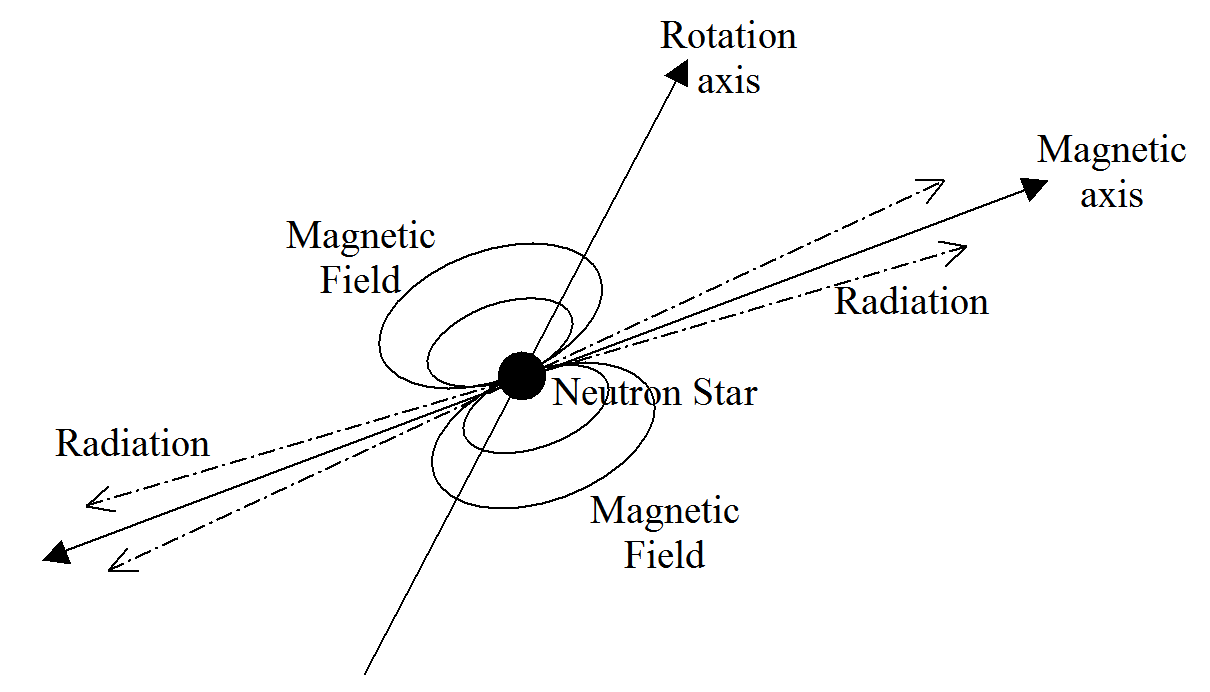Pulsar detection & verification with small-aperture antennas
2024 August 9
Following a brief introduction to pulsars and how to intercept radio-frequency transmissions from them, this article describes the design and results of an amateur project aimed at detecting and validating the strongest pulsar in the northern celestial hemisphere, with only a modest back-garden radio telescope. Techniques are described to improve verification confidence for weak, low signal-to-noise ratio observations by closer tracking of pulsar pulse train properties and also to identify the strongest pulsar scintillation sequence in the recorded observation data. The methods are illustrated based on an observation of pulsar B0329+54.
About pulsars
A pulsar, the likely end product of a supernova, is a highly magnetised, rapidly rotating neutron star some 10 to 15 km in diameter, that emits broadband beams of electromagnetic radiation out of its intense magnetic poles (Figure 1). If the orientation is such that a radio-frequency (RF) beam passes through our solar system, it is received in pulses that may be very accurately timed, with repetition rates ranging from milliseconds to several seconds depending upon the pulsar age.
The main electrical characteristics are very precise pulse timing, broadband noise radiation with much more power at low frequencies, and a pulse energy that scintillates in time/frequency and is dispersed in frequency due to electron interaction along the interstellar path.
Pulsars are among the weakest radio-astronomy targets and the most difficult for amateurs, even though a few thousand have been discovered in our galaxy by professional radio astronomers. The most powerful example in the northern celestial hemisphere within the capability of amateurs is B0329+54.
The typical radio telescope specifications required for successful amateur detection are an operating frequency range of 300 to 1,400 MHz, an antenna aperture of a few square metres, a bandwidth of a few MHz, a few hours’ integration time, a system noise temperature around 100 K, and, last but not least, a low radio-frequency interference (RFI) local environment.
Pulse-period-matched, synchronous integration or period folding of the detected signal is the most effective technique in recovering a true pulsar from galactic and receiver noise. This involves accurately dividing the detected data record into known pulsar period sections and parallel-adding these sections: if a pulsar is present then this technique ensures that it will appear in the same relative position and add linearly, whereas the system and galactic random noise adds power-wise, so the observed signal-to-noise ratio (SNR) increases as the square root of the number of periods added together.
Introduction
It has long been accepted that pulsar detection by amateurs is extremely difficult and that large antennas, complex receivers and sophisticated processing are all required to achieve any success. Some amateurs have, however, pioneered techniques with quite modest systems and this paper builds on their successes.1 In it, tools are shared that will enable an interested party in either of the Earth’s northern or southern hemispheres to design their own system and process the data, to confidently detect the strongest pulsar available to them.

The characteristics and properties used to separate pulsar signals from filtered noise and RFI are a regular, broadband, scintillating pulse train, with a very accurately known, stable period, and a known pulse width, dispersed in frequency and emanating from a known point in space.
The chance of success is improved by modern developments such as very low-noise amplifiers (LNAs), software-defined radios (SDRs), and easily constructed receiving antennas – all available with a minimum of expenditure – plus free processing software.
This paper begins by examining the fundamental radiometer equation to identify what system characteristics are important, and discusses how best to choose the antenna and main receiver components to facilitate amateur pulsar detection. The author’s basic system is outlined, together with some results and, finally, methods of validating detections. Validation of results is especially important for modest equipment, where the integrated pulsar target signal-to-noise ratio is less than about 7:1. The professional astronomer’s software PRESTO is designed to detect new pulsars; it is freely available for amateur use in data processing and RFI mitigation of pulsar data containing integrated/folded results exceeding SNRs of 7:1 or more.2,3 Small-aperture systems may not achieve this SNR level, so alternative techniques to improve confident identification for lower SNRs are proposed.
Members can view the full illustrated article in PDF format by returning to the previous page. Not a member? Why not join today?
https://britastro.org/wp-content/uploads/2024/08/Fig1.tif
| The British Astronomical Association supports amateur astronomers around the UK and the rest of the world. Find out more about the BAA or join us. |
